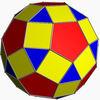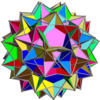| Small dodecicosidodecahedron | |
|---|---|

| |
| Type | Uniform star polyhedron |
| Elements | F = 44, E = 120 V = 60 (χ = −16) |
| Faces by sides | 20{3}+12{5}+12{10} |
| Coxeter diagram | |
| Wythoff symbol | 3/2 5 | 5 3 5/4 | 5 |
| Symmetry group | Ih, , *532 |
| Index references | U33, C42, W72 |
| Dual polyhedron | Small dodecacronic hexecontahedron |
| Vertex figure |  5.10.3/2.10 |
| Bowers acronym | Saddid |

In geometry, the small dodecicosidodecahedron (or small dodekicosidodecahedron) is a nonconvex uniform polyhedron, indexed as U33. It has 44 faces (20 triangles, 12 pentagons, and 12 decagons), 120 edges, and 60 vertices. Its vertex figure is a crossed quadrilateral.
Related polyhedra
It shares its vertex arrangement with the small stellated truncated dodecahedron and the uniform compounds of 6 or 12 pentagrammic prisms. It additionally shares its edge arrangement with the rhombicosidodecahedron (having the triangular and pentagonal faces in common), and with the small rhombidodecahedron (having the decagonal faces in common).
 Rhombicosidodecahedron |
 Small dodecicosidodecahedron |
 Small rhombidodecahedron |
 Small stellated truncated dodecahedron |
 Compound of six pentagrammic prisms |
 Compound of twelve pentagrammic prisms |
Dual
| Small dodecacronic hexecontahedron | |
|---|---|

| |
| Type | Star polyhedron |
| Face | 
|
| Elements | F = 60, E = 120 V = 44 (χ = −16) |
| Symmetry group | Ih, , *532 |
| Index references | DU33 |
| dual polyhedron | Small dodecicosidodecahedron |

The dual polyhedron to the small dodecicosidodecahedron is the small dodecacronic hexecontahedron (or small sagittal ditriacontahedron). It is visually identical to the small rhombidodecacron. Its faces are darts. A part of each dart lies inside the solid, hence is invisible in solid models.
Proportions
Faces have two angles of , one of and one of . Its dihedral angles equal . The ratio between the lengths of the long and short edges is .
References
- Maeder, Roman. "33: small dodecicosidodecahedron". MathConsult.
- Coxeter, H. S. M. (May 13, 1954). "Uniform Polyhedra". Philosophical Transactions of the Royal Society of London. Series A, Mathematical and Physical Sciences. 246 (916): 401–450. doi:10.1098/rsta.1954.0003.
- Wenninger, Magnus (1974). Polyhedron Models. Cambridge University Press. ISBN 0-521-09859-9. OCLC 1738087.
- Wenninger, Magnus (1983), Dual Models, Cambridge University Press, ISBN 978-0-521-54325-5, MR 0730208
External links
- Weisstein, Eric W. "Uniform Polyhedron". MathWorld.
- Weisstein, Eric W. "Small dodecicosidodecahedron". MathWorld.
- Weisstein, Eric W. "Small dodecacronic hexecontahedron". MathWorld.
This polyhedron-related article is a stub. You can help Misplaced Pages by expanding it. |
 , one of
, one of  and one of
and one of  . Its
. Its  . The ratio between the lengths of the long and short edges is
. The ratio between the lengths of the long and short edges is  .
.